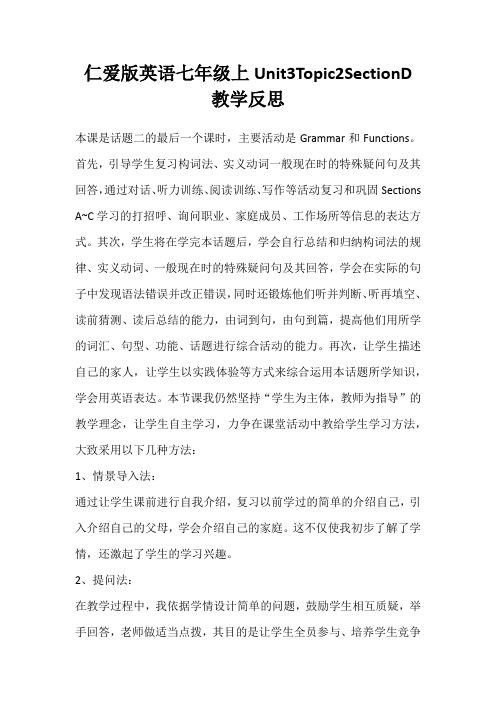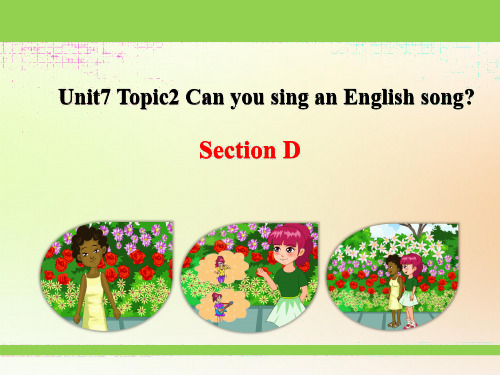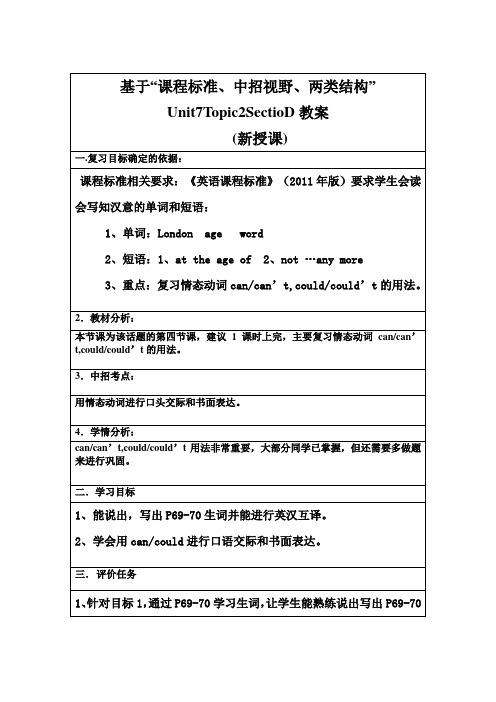【仁爱版】七年级上英语Unit2-Topic2.SectionD
- 格式:ppt
- 大小:8.28 MB
- 文档页数:15

Unit3 Topic2 SectionD 教学设计I. Material analysis本课是话题二的最后一个课时,主要活动是Grammar和Functions。
引导学生复习构词法、实义动词一般现在时的特殊疑问句及其回答,以及通过对话、听力训练、阅读训练、综合探究等活动复习和巩固Sections A~C学习的打招呼、询问职业、家庭成员、工作场所等信息的表达方式。
另外,学生将在学完本话题后,学会自行总结和归纳构词法的规律以及实义动词一般现在时的特殊疑问句及其回答,学会在实际的句子中发现语法错误并改正错误,同时还将锻炼他们听并判断、听再填空、读前猜测、读后总结的能力,提高他们用所学的词汇、句型、功能、话题进行综合探究活动的能力。
此外,在project的综合探究活动中,借助全家福,让学生以实践体验等方式来综合运用本话题所学知识,学会用英语做事情。
II. Teaching aims1. Knowledge aims能根据已学语音、音标及发音规则,正确朗读下列词汇并在实际的对话操练中加以应用:cute, play, its, love能根据本话题已学知识,自行总结和归纳构词法、实义动词一般现在时的特殊疑问句及其回答:teach—teach er, act—act or在教师的帮助与指引下,通过对话操练、听力训练、阅读训练、综合探究等活动复习和巩固有关打招呼、询问职业、家庭成员、工作场所等信息的表达方式,如:(1)—Glad to meet you.—Glad to meet you, too.(2)—What does your father do?—He is a doctor.(3)—Where does he work?—He works in a hospital.(4)—Who is the man in yellow?—He is my uncle.2. Skill aims能听懂有关询问职业、家庭成员等简单对话或叙述并完成相应的任务;能根据图文就职业、工作场所、家庭成员等基本情况的话题进行交流;能够在图片的帮助下进行阅读,理解大意、细节等,并按要求进行语言活动;能根据提示书面介绍自己或同伴的家庭成员的工作情况。

仁爱版英语七年级上Unit3Topic2SectionD教学反思本课是话题二的最后一个课时,主要活动是Grammar和Functions。
首先,引导学生复习构词法、实义动词一般现在时的特殊疑问句及其回答,通过对话、听力训练、阅读训练、写作等活动复习和巩固Sections A~C学习的打招呼、询问职业、家庭成员、工作场所等信息的表达方式。
其次,学生将在学完本话题后,学会自行总结和归纳构词法的规律、实义动词、一般现在时的特殊疑问句及其回答,学会在实际的句子中发现语法错误并改正错误,同时还锻炼他们听并判断、听再填空、读前猜测、读后总结的能力,由词到句,由句到篇,提高他们用所学的词汇、句型、功能、话题进行综合活动的能力。
再次,让学生描述自己的家人,让学生以实践体验等方式来综合运用本话题所学知识,学会用英语表达。
本节课我仍然坚持“学生为主体,教师为指导”的教学理念,让学生自主学习,力争在课堂活动中教给学生学习方法,大致采用以下几种方法:1、情景导入法:通过让学生课前进行自我介绍,复习以前学过的简单的介绍自己,引入介绍自己的父母,学会介绍自己的家庭。
这不仅使我初步了解了学情,还激起了学生的学习兴趣。
2、提问法:在教学过程中,我依据学情设计简单的问题,鼓励学生相互质疑,举手回答,老师做适当点拨,其目的是让学生全员参与、培养学生竞争意识、思考分析问题的能力,达到活跃课堂气氛。
3、语言交际法:口语交际既是本课的重点又是难点。
由于上课前对学生了解不够,我的教学设计是采用循序渐进法,即:从单词开始,再用单词做句子,然后再编成对话表演,由易到难,由浅入深,使学生循序渐进的学习新知识,最后达到熟练掌握的效果。
如:“询问家人的职业和工作地点”的对话表演。
这段对话表演不仅突出了本课的重点,还锻炼了学生口语交际能力,重要的是使学生能够认识到进行相互交流的作用和地位,从而能恰如其分地运用语言。
4、小组合作法:在教师的帮助与指引下,通过对话操练、小组合作等活动复习和巩固有关打招呼、询问职业、家庭成员、工作场所等信息的表达方式;听力训练,先让他们扫清题目障碍,再进行听力,养成好习惯;通过阅读,锻炼他们提取信息的能力,以及写作能力,提高他们的合作意识,感受成功的喜悦,活跃了课堂气氛。




Teaching Plan for SectionA,Topic1, Unit2(Project English, Grade Seven)Self-introductionGood morning, ladies and gentlemen. Nice to meet you .I’m very glad to be here sharing my lesson with you. Today I am going to talk about Unit 2 Topic 1 Section A I have a small nose. I prepare to say the lesson from seven parts.Ⅰ、Analysis of the Teaching Material1. Status and function•Unit2 is the real beginning of the whole Junior Middle School English. The content in this unit is not only releated to the students’life , but also interested and colorful. This lesson tells us how todescribe a person and how to talk about possessions. Besideslearning this, students will also learn some words, phrases andexpressions of people's looks and so on. In this lesson, the main job is to understand the simple present tense using “have/has”.I willlead the students to pay attention to the new tense.2、Teaching Aims and Demands(1) Knowledge aimsa. Get the students master the words about parts of the body: nose, eye, head, face, hair, ear, mouth, neckb. Learn the simple present tense with “have/has” and understand some useful sentences:(1)I have a big nose.(2)They have round faces.(3)She has long hair.(4)It has big ears.c. Learn how to describe people’s appearances.(2) Skillful aimsa. Develop the students’ abilities of listening, speaking, reading and writing.b. Train the students’ abilities of communication.(3) Affective aimsa. Develop the students’ habits of paying close attention to the differences between Chinese culture and western culture.b. Strengthen the students’ conception of cooperation.c. Help the students feel the happiness of learning.3. Key points and difficult pointsAccording to the New English Curriculum Criterion and the students’ real situation, I choose the following materials as the key points and the difficult points of this class.(1)Key pointsa. Develop the st udents’ abilities of listening, speaking, reading and writing.b. Learn some information about people’s appearances.(2) Difficult pointsHow to use the simple present tense with “have/has”Part Ⅱ. Analysis of the StudentsThe students in my class are lovely and co-operative. Most of them are interested in English. They have learnt English for nearly three years. And they have learnt some basic skills of listening, speaking, reading and writing. But on one hand, they are eager to show themselves and want to have a try. On the other hand, in the daily life there are few chances for them to speak English and most of them are too shy to speak English in public or are afraid of making mistakes. So I will try my best to create a relaxing environment for them to practice using English.Part Ⅲ. Analysis of Teaching MethodIn this lesson I will mainly use Five Steps Method and Task-Based Language Teaching. I think if I want the students to improve their oral English, I must give them more chances to practice. That is “Learning by doing, learnin g by using”. In this case, by designing tasks according to the New English Curriculum Criterion, I will lead my students to study and cooperate with each other.Part Ⅳ. Analysis of Learning MethodThe main feature of the Task-Based Language Teaching is the students’ participation and creation. So I plan to enable the students to use “self-learning” and “co-operative learning” as their learning methods Thus, the students are required to do as follows:1. Be well prepared for the new lesson, look up some necessary information.2. In the class learning, the students should work actively and finish the tasks efficiently.3. The students should learn to work with others from their bottom of hearts.Part V. Analysis of Teaching ProceduresStep 1 Warming-up and Review(1)Show a table about Jane. Create a proper atmosphere for the new lesson . Then let the students answer the questions according to the table.T: What’s her name?S1: Her name is Jane.T: How old is she?S2: She is twelve.T: Where is she from?S3: She is from Canada.T: What class is she in?S4: She is in Class Four, Grade Seven.T: What’s her telephone number?S5: It’s (010)9267-6929.(2)Let the students look at a picture and review the words: eye, nose, mouth, ear, neck, head, hair.(3) In order to make the students remember the words quickly, I deside to play a game with them. And the name of the game is “Touch your body.”I say “Touch your nose”, the students touch it quickly. I’ll Praise the students with “well done. You are wonderful.Excellent” and so on . Reason: It is necessary for the students to review learned knowledge. Through this activity, the students can be cheered up, too.Step 2 Presentation1. Show some pictures and teach the phrases, such as, “a small nose, a wide mouth, long hair, big eyes, and so on.2. Let the students observe the picture, and try to say:She has long hair. He has a wide mouth.He has short hair. She has big eyes.3. Let the students read 1a after the tape and pay attention to the pronunciation and intonation. At the same time, let the students underline the words and phrases that they don’t understand.4. Read 1a again and complete 1b,check the answers. Encourage the students to get help from their group members.Reason: This step aims to make the students get the general idea of the article.Step 3 Consolidation1.Let the students look at the chart and discuss in groups. Showyourself. They will say: I have a small nose. He has a wide mouth.They have big eyes. She has long hair.2.I’ll let some students come to the front. Other st udents describehim/her using their words. They will feel excited.Reason: The step aims to make the students not only practicetheir speaking ability but also feel the happiness of learning. Step 4 Practice1.Work in groups. Show a picture and let the students writedown her appearance. Let them list as many sentences aspossible in groups.2.I’ll give the students some chances to shoe their passages infront of the students.Reason: Task-based language Teaching Method is used here to develop the students’ ab ility of writing and also their ability of their cooperation will be well trained.Step 5 HomeworkAfter class, I’ll let the Ss Write a passage about Jim’s appearance in the exercise book. I think homework is so important that the Ss should speak English as much as they can in class or after class. It is necessary for the Ss to do some exercises after class to consolidate the knowledge they learned.Blackboard Design:Reason: In this step, I’ll write the important words to help the students understand the present tense with have/has.Reflection about this lesson1. In the teaching process, we should encourage the students to join, observe, practice, think independently and cooperate. Change their thought from “I have to study.” to “I want to study.”2. As teachers, to make our English classrooms shine with vitality, we are laid with heavy burden, and we still have long way to go.Teaching Plan for SectionA,Topic1,Unit2(Project English, Grade Seven)。
Unit 2 Looking different Topic3 Whose jacket is this第一课时SectionA一.目标语言 Target language(1)重点单词和短语 Words expressionsWhose,his,hers,ours,theirs,yours,mine,then(3)Key sentences—Whose …is it/are these/those…?—It’s (not) mine/hers/yours/these/those are (not)……(3)Teaching important point1 学习物主代词,初步了解名词所有格2 学习谈论物品的所属3 复习名词的复数形式(4)Teaching difficult point1 如何使用名词性物主代词替换掉形容词性物主代词+名词的组合2 then的用法3 如何回答Whose引导的特殊疑问句4 名词单复数形式的变化二.教学呈现Teaching proceduresStep1:Greating(2分钟)Step2:Leading(2分钟)T:I find a pen in my bag. It’s red.It’s not my pen. It’s not mine. Then whose pen is it?—Is it your pen Marssar?—No. It’s not my pen.—Is it yours, Cline?—No. It’s my pen.—Ok.Do you want to find the owner of this pen?—Yes.—Then,let’s study our new topic. “Whose jacket is this?”Step3:Studying the new words(6分钟)1Turn to page 1262Leading the students to read the new words3Pay attention to these words: whose, then, hers, ours, theirs, yours, babyStep4 Preside ting (27分钟)1 拿出属于自己的一件或多件物品,进行师生问答。